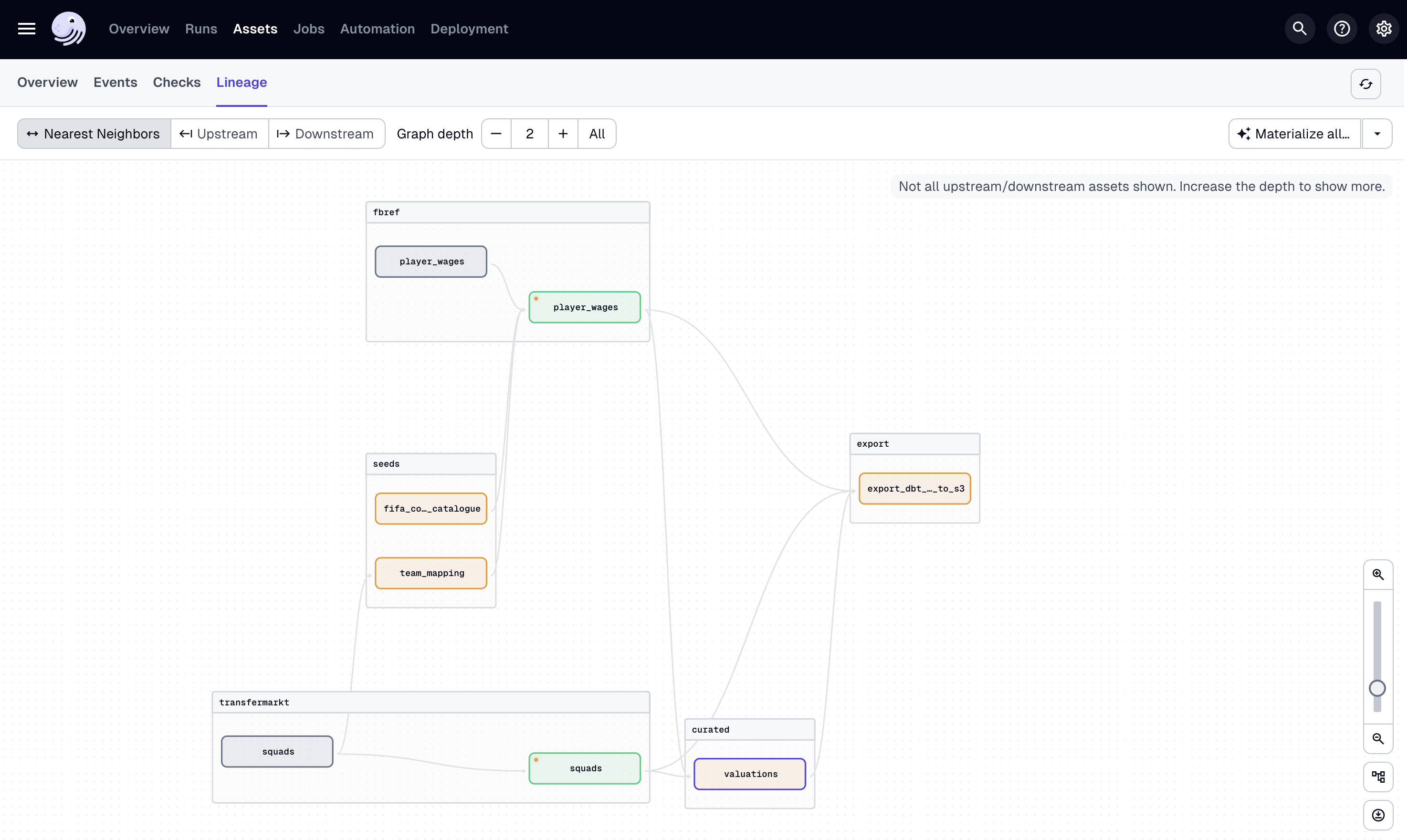This project is intended as a data warehouse for football data from various sources.
There are currently two sources of data:
FbrefTransfermarkt
Essentially, public data is parsed from these two sources using the football-data-extractor repository,
cleaned using dbt and Duckdb,and stored locally in Duckdb which acts as a local data warehouse. Both raw and processed
datasets are also stored in an Amazon S3 bucket.
The data pipeline is automated using Dagster.
To setup the project in your local environment, follow the steps below:
- Clone the repository
git clone https://github.com/chonalchendo/football-data-warehouse.git- Install uv for package management
pip install uv- Setup the virtual environment
uv venv --python 3.12- Install the required packages from
pyproject.toml
uv sync- Activate virtual environment if not already activated
source .venv/bin/activateThere are a few ways to run the data pipeline that will populate Duckdb with data from the sources mentioned above.
To house many of the commands that are used to run the pipeline, a Makefile has been created. You can view the commands
either by simply looking inside the Makefile or by running the command below:
make helpThis will output the following:
Available commands:
make dagster-dev : Run dagster dev server
make dagster-run-asset : Materialise a specific dagster asset
make dagster-asset-partition : Materialise a specific dagster asset partition
make dagster-job-partitions : Run a specific dagster job with partitions
make dbt-build : Run pipeline for dbt assets
make dbt-compile : Compile dbt modelsThis is a good way to visualise the pipeline and to see what assets (datasets) are being produced at each step.
You can also view the jobs that are created to manage different parts of the pipeline for example, fbref_stats_job is dedicated
to extracting and cleaning the fbref player statistics datasets such as player shooting and passing stats.
To run the pipeline using the Dagster UI, run the command below:
make dagster-devThis will start the Dagster server and you can view the UI by navigating to http://localhost:3000.
Here is an example of what the Dagster UI looks like:

This image shows the flow of data to create the valuations dataset before exporting to Amazon S3.
You can run this pipeline by selecting Materialize all in the top right corner.
To run assets or jobs from command line, you first have to check assets and jobs are available. You can check
by referring the Assets and Jobs section in the Dagster UI.
To run a specific asset run the following:
make dagster-run-asset ASSET=<asset_name>Replace <asset_name> with the name of the asset you want to run.
To run a specific asset partition run the following:
make dagster-asset-partition ASSET=<asset_name> SEASON=<season>Replace <asset_name> with the name of the asset you want to run and <season> is the season you would like to scrape or process data for.
For example, you could run:
make dagster-asset-partition ASSET=raw_player_passing SEASON=2022This command would run the raw_player_passing asset for the 2022-2023 season.
You can also run a specific job with partitions using the following command:
make dagster-job-partitions JOB=<job_name> SEASON=<season>An example of this is:
make dagster-job-partitions JOB=fbref_stats_job SEASON=2024By default, any raw assets parsed using the football-data-extractor are stored in the data/raw directory.
If you would just like to run the processing pipeline, you can use dbt which will materialise the processed
assets into Duckdb.
To do this, use the following command:
make dbt-buildThe data is stored in Duckdb which is a lightweight, in-memory, OLAP database which is great for local development and
acts as a local data warehouse.
To access data parsed and processed by the pipeline, there are two options:
- you can use the
DuckdbCLI.
duckdb dbt/duckdb/database.db -c 'select * from valuations'- you can use the
DuckdbPython API.
Using the Duckdb Python API, you can convert the data to a pandas or polars DataFrame depending on which package you perfer for further analysis.
import duckdb
conn = duckdb.connect('dbt/duckdb/database.db')
# run a query and return the result
conn.sql('select * from valuations')
# convert to pandas
df = conn.sql('select * from valuations').df()
# convert to polars
df = conn.sql('select * from valuations').pl()Fbref is a website that provides detailed football statistics such as player shooting and passing stats. The data is taken from tables such as the ones found here
Tranfermarkt is a well-known football website that provides great data on player market valuations, transfers, and match statistics. The data is taken from tables such as the ones found here
All cloud based infrastructure is managed using Terraform. The infrastructure is defined in the infra directory. Currently, there is no read access to the S3 bucket for public consumption. This is something that will be added in the future.
- Add more data sources such as
UnderstatandSofascore - Add more data processing steps such as feature engineering and data visualisation
- Pushlish data sources to a public S3 bucket for easy access
- Publish to public data areas such as
Kaggle